STUDENTS HOLD PROTEST JOINING IN PUSH FOR WOMEN’S RIGHTS IN IRAN, AFGHANISTAN
Iranian students share their stories and thoughts following the death of Mahsa Amini
BY SONORA SLATER campus@theaggie.org
Content Warning: This article contains discussion of violence which some readers might find disturbing.
Note: Some names have been concealed for the safety of Iranian student sources.
At 12 p.m. on Oct. 17, students crowded the front of the Memorial Union carrying signs that read “Women, Life, Freedom,” “Free Iran” and “#MahsaAmini,” in a “[show of] solidarity with the women of Afghanistan and Iran, who are putting their lives on the line to fight for their basic freedoms and rights,” according to an Instagram post by the UC Davis Afghan Student Association.
The undergraduate group organized the event in collaboration with the Iranian Graduate Student Association at UC Davis in response to ongoing protests against the Iranian government sparked by the Sept. 16 death of 22-year-old Mahsa Amini and other young women in Iran.
According to an article published by IranWire on Sept. 15, Amini was on a trip to the capital with her family when she was arrested by the Iranian “morality police” on the grounds of improper wear of her hijab. Agents told Amini’s brother that she was being taken to the station for a one-hour “re-education class,” but when he got to the building, he heard screams coming from inside. Soon after, according to the article, an ambulance left the building, which was later found to be carrying Amini to the hospital.
Tehran Police issued a statement claiming that Amini had suffered from a pre-existing heart condition, despite multiple eyewitnesses testifying that
they saw officers beat her in the police van after her arrest, according to an article by NPR.
The article goes on to say that Amini’s death has become “the heart of a rallying cry for Iranians who want more freedoms and rights for women,” as many women burn their hijabs, protesting the government’s restrictive laws against women and calling to dismantle the morality police.
Students who gathered for the UC Davis protest listened to second-year mathematics and physics double major Parnian Sartip give a speech addressing the situation in Iran before marching around the Quad and chanting phrases similar to those written on their signs.
“In some countries like the U.S, women and men alike are granted the

ability to wish for a trip to the moon,” Sartip said in her speech. “Even here [...] we have a long way to go to get to gender equity, but only a few glances away on a world map, these dreams change. [...] In Iran and Afghanistan, no one thinks about going to the moon.
Men and women are hungry there. They do not have the privilege of a respectable job and a good education.
Forget privilege, people lack human rights there.”
Sartip then anecdotally described the experience of women in Iran and Afghanistan, referencing a lack of choice in attire, rules against showing their hair, limited options for education, arranged marriages at a young age and even an inability to legally ride a bicycle.
“I’ve had no voice in these laws,” Sartip said in her speech. “I cannot
UC DAVIS GRADUATE STUDENTS VOTE IN FAVOR OF STRIKE AUTHORIZATION VOTE

Workers rallied at the quad demanding better treatment from UC Davis
become a judge. At court when called to testify, my word is worth half a man’s. So is my inheritance, so is my life. If I am half the population, if I am the mother of future generations, if I am human, then why am I worthless?”
She went on to say that in Iran and Afghanistan, women have “always been voiceless,” but noted that she believes the “righteous fury” over Mahsa Amini’s death was a turning point that inspired many to action.
“Today, standing next to Memorial Union, we remember these women,” Sartip said. “We continue to stand with them and shout with them, as if we are of one heart, in one place. The truth is simple: we all deserve bread, work, life and freedom. Whether we are man or woman. Better yet, if we’re just human.”
Dena Sayrafi, a fourth-year
biomedical engineering major and the president of the UC Davis Afghan Student Association, said that many Iranian and Afghan students have expressed “[feeling] helpless, since they cannot directly fight for Iran’s freedom.” According to Sayrafi, this protest was one way she felt students could use their voices to help.
“Through protesting, we have gained the attention of the world on the horrendous acts transpring in our home country,” Sayrafi said via text message.
“As students, we have the opportunity to mobilize and use our voice and that is what this protest is about. Iranians have come together on this day to show the world that things must change, our people must be given their basic human rights and that every individual is entitled to their own freedom.”
A statement attached to a petition created by “allies of the IranianAmerican community at the University of California” calls upon readers to “publicly [condemn] state violence against the people of Iran,” and endorse a Sept. 20 statement made by the Association for Iranian Studies and the Middle East Studies Association.
“The international community has not condemned this violence strongly enough,” the statement reads. “[It] is thus signaling to Iran’s security forces that they have full immunity in their suppression of peaceful protesters. Now more than ever, we need to show solidarity.”
On Sept. 28, UC Davis released a joint statement issued by UC Davis Chancellor Gary May and others in leadership at the university, providing “resources and support for those impacted by unrest in Iran.”

DAILY PARKING RATES TO INCREASE FOR ON-CAMPUS RESIDENTS WHO WILL NO LONGER RECEIVE AFFILIATED RATE
Residents of on-campus housing will now return to paying the nonaffiliated rate of $15 per day
BY CHRIS PONCE city@theaggie.org
On Oct. 13, UC Davis workers rallied together at the quad, calling for a strike authorization vote as part of the Union of Postdocs and Academic Researchers’ (UAW) October Mass Membership Meeting. The UAW’s Davis chapter list of demands include decreasing rent burden, a higher
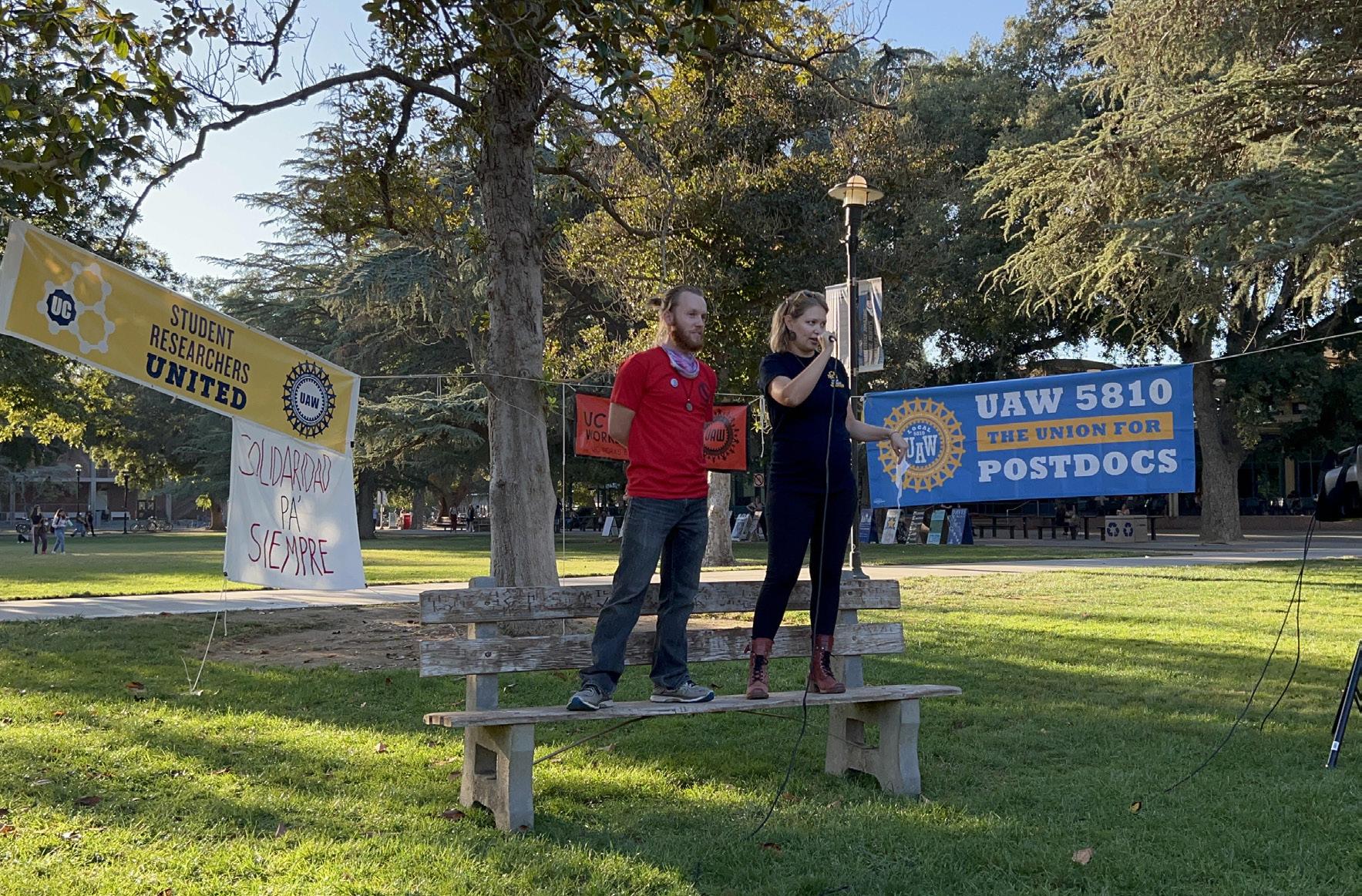
minimum salary, better childcare and more. According to a Tweet by the UAW, over 600 workers gathered for the cause.
According to a Google spreadsheet created by The UAW, issues that are on the negotiation table include but are not limited to: appointments, benefits, childcare, compensation, housing, layoffs, leaves of absences, management and academic rights, no strikes, parking and transit, President’s Postdoctoral Fellowships, reasonable accommodations, relocation reimbursements, work authorizations, duration and international scholar and immigrant support.
Graduate student employees and organizers took to the megaphone to explain why they are voting yes on a strike. Sarah Gooding, a Ph.D student with the UC Davis Neuroscience Graduate Student Association (NGSA) spoke about her and her partner’s experiences as expecting parents and graduate students.
“The cost of infant child care in Davis is over $2,000 a month,” Gooding said. “It costs $432 a month minimum to add a child to our UC SHIP Health plan. That’s [my partner’s] stipend — it’s gone now. That leaves mine to cover rent, our utilities, food, vehicle cost, everything else you need to take care of a family of three. How many of you feel really good about supporting a family of three on your monthly stipend?”
The crowd of concerned workers booed as a response to this question.
One person in attendance even shouted that they can barely support themself with the stipend. Gooding criticized UC Davis for their lack of family care.
“They can not call themselves champions of gender equity or diversity in academia while they continue to champion policies that are fundamentally incompatible with being a parent,” Gooding said.
Multiple speakers followed, sharing their stories of feeling unsupported by UC Davis. Wen Guan, a Ph.D student and teaching assistant in the sociology department, talked about her experience as an international student at Davis.
“As an international student, just like all of the other ones, we crossed the oceans and continents, come to this country, this school for better education and better life,” Guan said. “We never ask [for] money from this country. Now our first demands is stop taking more money out of our pockets.”
Before the authorization vote, organizers passed the megaphone to people in attendance, each of whom shared why they are voting yes on authorization.
One person said, “I’m voting yes because half of my paycheck goes to rent.”
Another added, “All we’re asking for is to be able to afford our rent, to be able to buy groceries, to be able to not have a heart attack when we’re putting gas in our cars.”
BY SYDNEY AMESTOY campus@theaggie.org
On-campus residents who drive to campus, including those who live at the Green at West Village, can expect a price increase in their Parkmobile daily parking bill, according to information on the Transportation Services (TAPS) website.
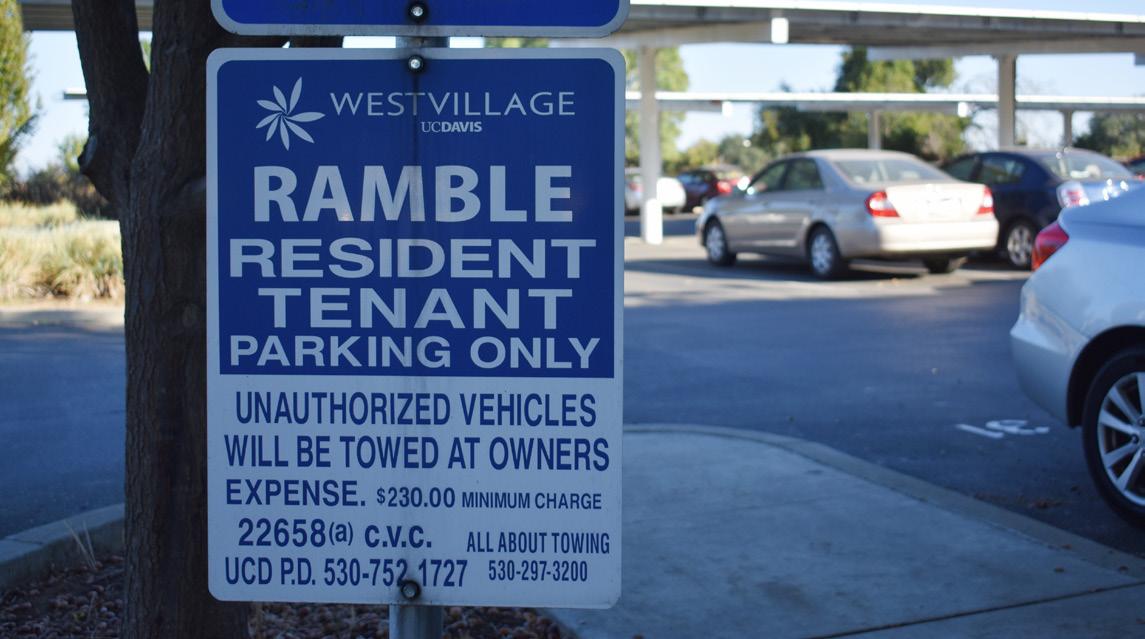
This change comes as TAPS has switched on-campus resident drivers from the affiliated rate of $3.50, which they received access to during the pandemic, to the nonaffiliated rate of $15 that they paid pre-pandemic. Those living in residence halls and in oncampus apartments were informed of the switch through their student email accounts before the change occurred.
On-campus residents paying the nonaffiliate rate is a policy that is not new, but was only temporarily changed, according to the executive director of the service, Dr. Perry Eggleston.
“Since the campus was on reduced operations due to the pandemic, University leadership allowed Transportation Services to offer affiliate rates to residents these past two years,” Eggleston said via email. “Now that the campus population and vehicles have returned, the University leadership asked us to reinstate the policy.”
TAPS encourages students to use alternative transportation to get around campus to avoid the daily charge, according to Eggleston.
“Resident students have access to Unitrans, biking, walking, and other travel amenities,” Eggleston said. “Thus, storing their cars on campus only adds
to the traffic congestion with the return to ‘normal’ operations.”



The ASUCD Senate had this issue brought to their attention by Senator Vaneza Gonzaga during the open discussion period of the Oct. 6 senate meeting.
“A lot of students have gone into this academic year planning on driving everyday, so that’s the investment they’ve made with their cars and such, so if it’s going to be $15, that’s extremely expensive,” Senator Gonzaga said. “Bikes are also expensive, which is one of the solutions they offered as an alternative.”
Senator Zeph Schnelbach also shared their thoughts during the discussion.
“[Transportation Services] sees it that if you live on campus, you don’t need to have a car, but I would like to remind the table that the Green is over a mile away from campus,” Senator Schnelbach said during the meeting.
Senate discussion continued on the topic during the Oct. 13 meeting regarding what, if any, action the senate would take about the reinstatement of the policy.
“I asked the internal vice president [JT Eden] for an update on the plans, and we are currently planning for some reps from transportation services to come to a meeting so we can ask them questions about the increase,” Senator Gonzaga said. “[We want] to see if there are solutions that work with TAPS and are still fair for students living on campus.”
FOLLOW US ON SOCIAL MEDIA @THECALIFORNIAAGGIE @CALIFORNIAAGGIE @CALIFORNIAAGGIETHE CALIFORNIA AGGIE SERVING THE UC DAVIS CAMPUS AND COMMUNITY SINCE 1915 THEAGGIE.ORG VOLUME 141, ISSUE 5 | THURSDAY, OCTOBER 20, 2022
JOANNE SUN / AGGIE
IRANPROTEST
on 6
TAPS is raising the parking rate for residents living in West Village and residence halls to the non-affiliated rate of $15/day. (Kayla Bruckman / Aggie)
READ MORE UC DAVIS ICES NORTHERN ARIZONA ON HOMECOMING NIGHT SEE PAGE 3 The Aggies turn in a spectacular performance en route to a 56-27 victory. GREENTAPS on 6STRIKE on 6
Protesters speak at rally in favor of UAW strike authorization vote.
(Chris Ponce / Aggie)
THE DOMES CELEBRATES ITS 50TH ANNIVERSARY
Generations of former and current members of the Domes gathered on Oct. 8 to celebrate the livinglearning cooperative community
BY KAYA DO-KHANH campus@theaggie.org
Located on the northwest edge of campus, the Domes is a living-learning cooperative community consisting of 14 fiberglass domes that 26 students call home. In the 1970s, the white, igloo-like community of domes was created as an experiment in affordable and communal student housing; it was only supposed to last seven years, but on Oct. 8, people gathered for the 50thanniversary celebration of the Domes.
The public celebration included speeches from the Domes’ founders, the current president of the Domes, representatives from Sustainable Living and Learning Communities at UC Davis and the Solar Community Housing Association.
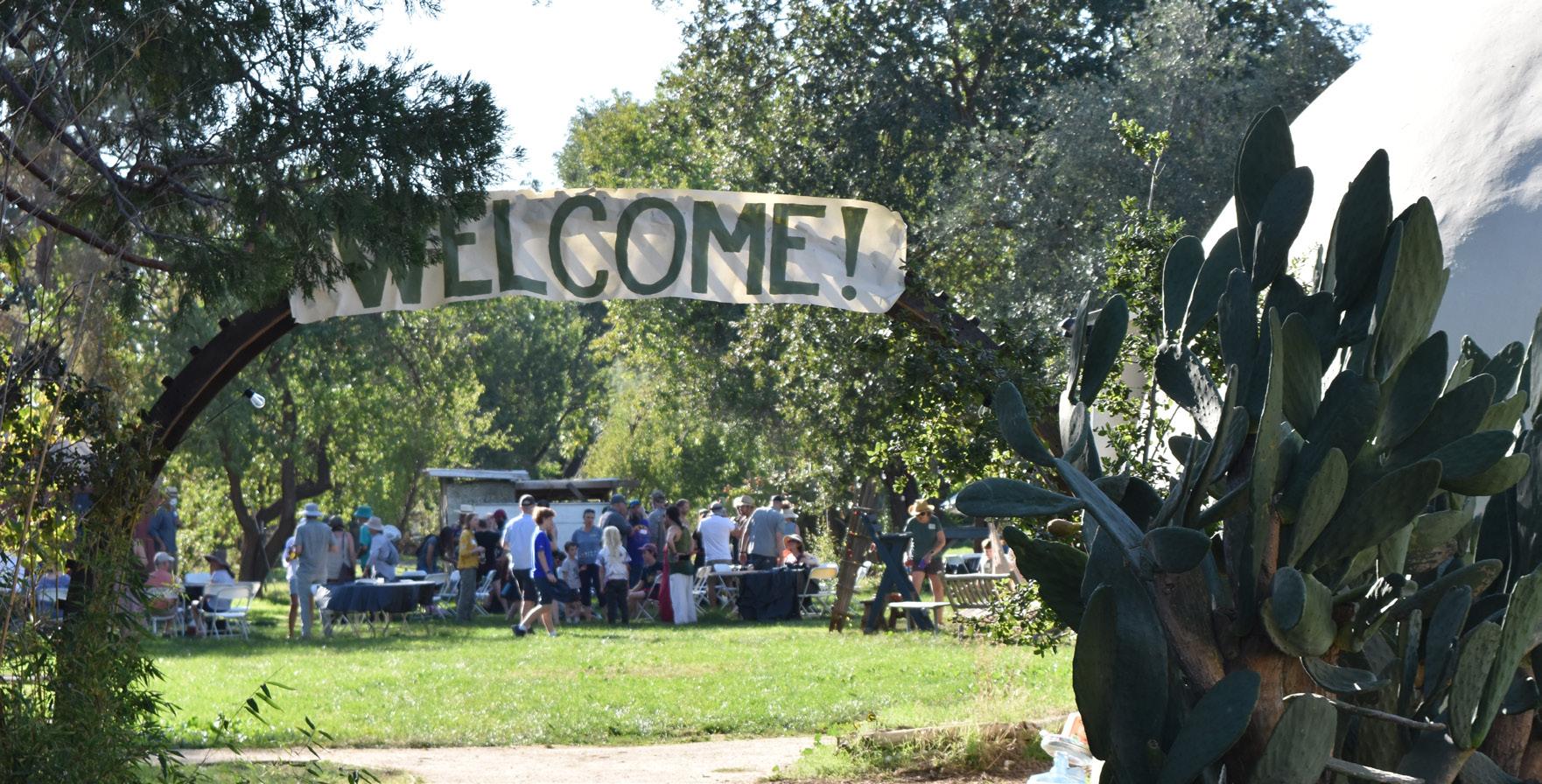
There were tables of old photographs of the Domes, as well as journals with the original sketches of the Domes for people to flip through. Generations of ‘Domies’ (the nickname residents call themselves) attended, wearing name tags that had the dome number they lived in, and gathered around the tables looking at pieces of the past and sharing stories.
During the event, attendees were invited to explore the Domes landscape and take a tour of a dome that was undergoing renovation. After the public celebration, there was an after-party for Domies only.
The current president of the Domes,
sustainable agriculture and food systems major Dexter Hampton, gave a speech at the celebration, first taking a moment to remember the history of the land and recognize the Indigenous people who first occupied it.
“The sense of wonder and magic that this space offers never really goes away,” Hampton said. “There’s really nothing like it in Davis or really most other places for that matter. There’s such a strong sense of creativity and passion in this space and in these structures.”
Ben Pearl, a project manager for the Solar Community Housing Association who has been living and working with co-ops in Davis for 12 years, spoke to the audience about how challenging the pandemic was for the Domes.
When the pandemic started, the community had just secured a longterm ground lease for the property through 2035. At the same time, the community could also apply for loan funding and was able to kick off longawaited renovations of the Domes.



“Every time that another entity has proposed putting something else in this space on the campus map, the community has come together to work together to save them,” Pearl said.
He then proceeded to recognize Domies of different generations by having different groups, from the original Domies who built the
community from 1972, up to the current generation of Domies, stand up.
One of the founders of the Domes, Clay Brandow, was heavily involved in the building of the Domes and gave a detailed description of the process in a 2015 TEDx talk at the Mondavi Center.
He said that the hardest thing about living in the Domes “was having faith, despite many setbacks, that we would actually complete the project. I think that is why I ended my TEDx talk with, ‘If you want to make an improbable project happen, you have to be patient,
persevere and adapt.’”
Brandow said that the biggest change in the Domes since 1972 is that they used to be very isolated, because Highway 113 was just a twolane country road at the time, and there was not much east of La Rue Road.
Additionally, he shared that “the Domes used to be multi-colored, so everyone chose their own color. Mine was forest green, and there was one that was kind of psychedelic. Chris Gerrie [...] had a whole bunch of different colors, and so he just splattered them like Jackson Pollock.”
Brandow spoke about meeting his wife, Brooke Brandow, at the Domes, and said that a conversation with one of his fellow founders, Jim Chiles, changed the trajectory of his life by swaying him toward further pursuit of a job. Brandow said that he would have lived a completely different life if not for the Domes and its community.
“The Domes are great, but the friends that I made are the most precious thing,” Brandow said.
He also mentioned that Ellery
Sorkin, another founder of the Domes, was very instrumental in the planning process, stating that it would not have happened without him.
Sorkin said that in the 1970s, he placed an advertisement for the Domes in The California Aggie, announcing a meeting for students interested in alternative housing.
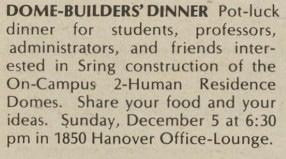
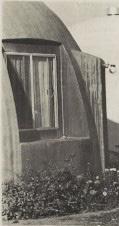
Sorkin, a law student at the time, said that he made sure everything was signed and dated as he engaged in sit-ins, proposing the Domes to thenChancellor Jim Meyer’s office. He described the beginnings of the Domes and explained how everyone was able to design where they wanted the doors and windows personally. According to Sorkin, their contractor at the time did not have his own license and used his dad’s.
“You can’t build housing for 30 kids with $110,000 — it just can’t be done, but we did it, because we did the work ourselves,” Sorkin said. “Ninety-five percent of the women and most of the guys had never held a hammer or a drill before, but they learned.”
BOARD GIVE QUARTERLY REPORTS
The Senate also passed bills to make their meetings run more efficiently at Oct. 13 meeting
BY SONORA SLATER campus@theaggie.org
The meeting was called to order at 6:10 p.m. by Vice President JT Eden. He then read the UC Davis Land Acknowledgement and called roll.
The Judicial Council chair confirmation was the first item on the agenda for the night but was pushed to a later date to allow more time to complete the hiring process, including interviews.
Next was a period for public comments. Senator Stephen Fujimoto congratulated UC Davis graduate students for voting to join other UC campuses in the process of approving a UC-wide strike authorization vote.
“They’ve been pushing for living wages, transportation subsidies and better benefits,” Senator Fujimoto said.
“If the unions do authorize a strike, I urge my fellow ASUCD members to stand in solidarity and push administrators to bargain with them fairly.”
Elected officials then gave reports on their activities for the week, including meetings, interviews for new committee members, office hours and more.
The Senate moved into quarterly reports, beginning with a report from The Pantry given by unit director and fourth-year human development major Abigail Nonnarath.

According to Nonnarath, The Pantry currently has around 115 volunteers, which it hopes to grow to around 150 throughout the quarter. Other goals for the fall include increasing their inventory of culturally diverse foods, labeling foods with nutrition information and expanding their refillable spice jar program.
In addition, Nonnarath said that they are working with UC Davis Stores in order to potentially offer scantrons and blue books to students in addition to their usual food items.
They are also in the process of moving their website to a new platform,
potentially moving their general operations from inside the Memorial Union to being near Gunrock Gaming and putting together a “mobile pantry” cart where students can pick up Pantry food orders at the Silo.
“I don’t know if you all knew how much work Abigail puts into The Pantry,” Senator Radhika Gawde said following the presentation. “I hope you have some indication of it now.”
Fourth-year political science major and General Manager of KDVS Cate Hatcher then gave the radio station’s quarterly report.
According to Hatcher, the station trained 20 DJs over the summer, hosted three live music events and had 94 student attendees at their recent DJ training info sessions. During the rest of fall quarter, they hope to train around 30 more radio DJs, run their fall fundraiser, solidify plans for the station’s move to a new location on campus and complete repairs to their currently broken broadcast tower controller.
Hatcher said that in addition to difficulties with the tower taking them off the air, KDVS has struggled with unreliable internet in their current location of Lower Freeborn Hall.
“It essentially nullifies everything we’re doing down there,” Hatcher said. “That’s one of the reasons we’re so excited to move, but for now it’s kind of a basic needs issue that isn’t being met. It’s not as much fun to be a radio DJ when no one can listen to you.”
Although plans are now in place to fix the controller by the end of the month, it has been broken since midSeptember, and Hatcher said that their organization is concerned about the damage this nearly month-long gap of being off-the-air could have on their listener base and credibility.
Following Hatcher’s report, thirdyear economics major Jesse Goodman, this year’s Picnic Day Chair, gave the
“I think we have a lot of momentum coming off of a great Picnic Day last year,” Goodman said.
According to Goodman, the event team is still in the process of hiring, so he didn’t have much to report yet, but he did mention plans to problemsolve issues related to the Doxie Derby in the coming year. Due to an excess of demand for the event, the U Center couldn’t accommodate the large crowds in 2022, leading Goodman to suggest a ticketed, albeit still likely free, approach in order to maintain more control over the number of attendees.
The Senate then took a break and was called back to order at 7:34 p.m., at which time they reviewed the status of past legislation before moving into the
consideration of old legislation.
SB #6, which seeks to streamline the placing of “noncontroversial” ASUCD Senate bills on the Consent Calendar in order to increase the efficiency of Senate meetings, passed unanimously.
SB #7, which, in the case of a Senate meeting exceeding five hours in length, allows elected officer reporters to be submitted via writing rather than verbally, passed unanimously.
SB #8 allows members of the public to submit written comments in advance of a meeting of the ASUCD Senate. After discussing concerns about how to facilitate submissions and how to respond to public comments submitted virtually, amendments were made to the bill and it was then passed unanimously.
CA #77 moves elections of the ASUCD Transfer Student
CA #78 moves the election of the External Affairs Vice President from fall quarter to spring quarter. There was a unanimous vote, and the decision is now on the ballot for this year’s fall quarter elections.
SB #13, which allocated $635 to the ASUCD CoHo for the purpose of hosting ASUCD-sponsored drag show ‘Java and Drag,’ passed unanimously.
The Senate approved past meeting minutes, and the meeting was adjourned at 8:39 p.m., nearly two hours ahead of schedule.
2 | THURSDAY, OCTOBER 20, 2022 THE CALIFORNIA AGGIE THE PANTRY, KDVS RADIO, PICNIC DAY
CHRISTINA LIU / AGGIE
Picnic Day quarterly report, expressing excitement for next spring’s event.
The Domes have been open for student housing at Davis since fall 1972. Students and alumni celebrate the 50th anniversary of the Domes on Saturday, September 8th. (Christine Minarik / Aggie)
Representative and the International Student Representative from fall quarter to spring quarter. There was a unanimous vote, and the decision is now on the ballot for this year’s fall quarter elections.
Clippings from The Aggie’s newspaper archives from 1972 and 1973, when the Domes were first occupied by students. (Aggie)
The original advertisement for the Domes that Ellery Sorkin published in The Aggie on Dec. 1, 1971 (Aggie)
UC DAVIS ICES NORTHERN ARIZONA ON HOMECOMING NIGHT
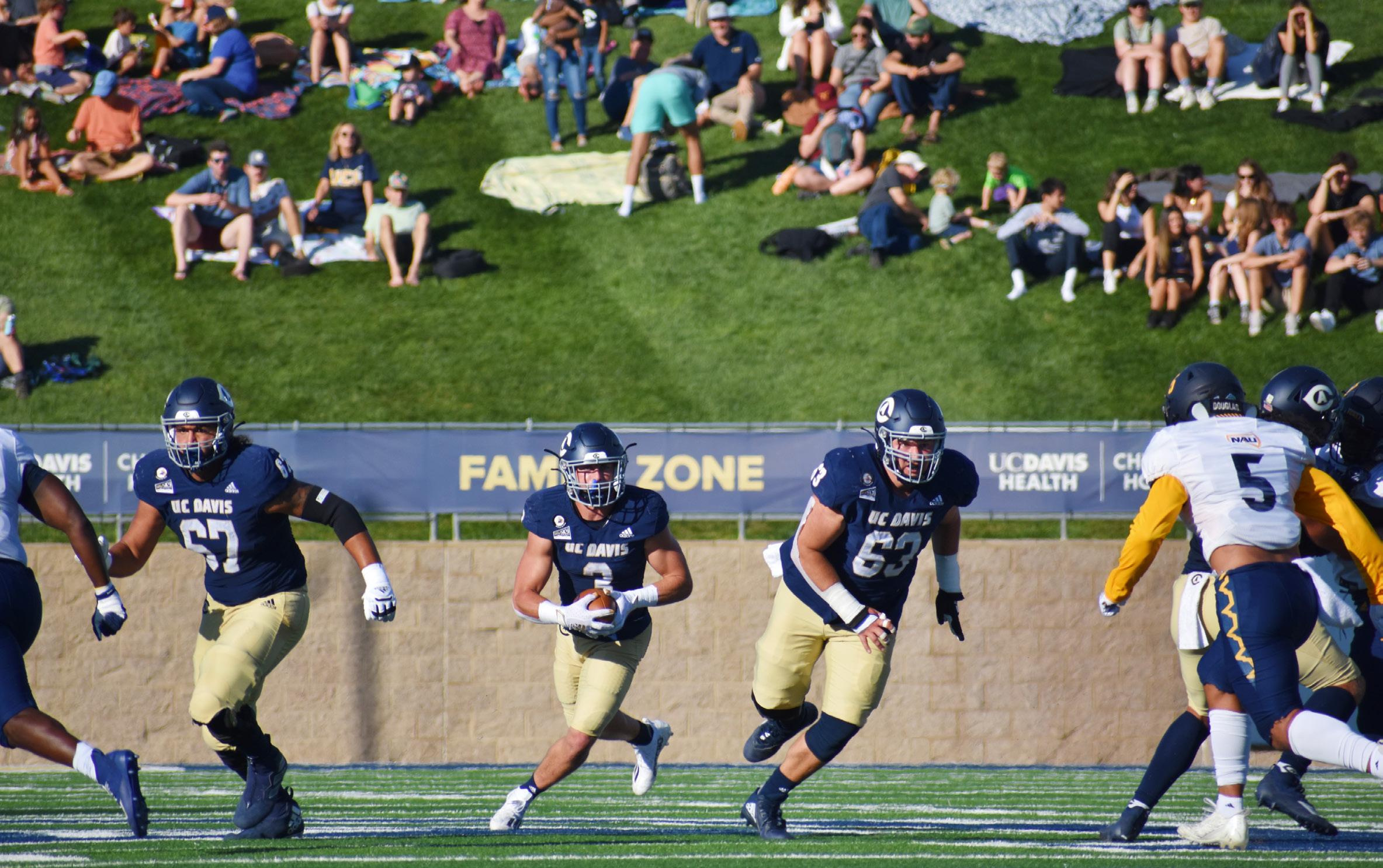 BY GABRIEL CARABALLO sports@theaggie.org
BY GABRIEL CARABALLO sports@theaggie.org
The sun was shining and the weather was clear as the UC Davis Aggies marched onto their home field at UC Davis Health Stadium to play against the Northern Arizona University (NAU) Lumberjacks on Saturday, October 15.
The Aggies won the coin toss and elected to defer to the second half as they claimed the rights to the opening kickoff. NAU returned the ball to their 20-yard line and began their first drive of the game. With the first quarter underway, the Lumberjacks gained first down after first down, resulting in a 14-play, 52-yard drive. However, the Aggies’ defense fought back and forced a 45-yard field goal which the Lumberjacks completed, making the score 0-3.
With under 10 minutes left in the first quarter, UC Davis began with an impressive 33-yard kickoff return by second-year running back Lan Larison. After an early penalty, the Aggies gained two quick first downs but were stopped by the Lumberjacks’ defense, who took the play to fourth down and short. Head Coach Dan Hawkins made an aggressive move and went for it on fourth down. Second-year quarterback Miles Hastings threw a six-yard pass to second-year wide-receiver Chaz Davis for a successful fourth-down conversion, setting the tone for the rest of the game.
“That’s kind of my nature, I love to be on the attack and I want us to play aggressive,” Hawkins said regarding the early fourth-down conversion.
This play gave the Aggies energy to continue their series, powering down the field for a 67-yard drive that resulted in the first touchdown of the game — courtesy of an eight-yard carry by Larison. With the score now 7-3 Aggies, NAU repossessed the ball and began their second drive of the quarter with a little over four minutes left in the first quarter. The Aggies’ defense took the Lumberjacks to third down, but secondyear quarterback RJ Martinez danced in the pocket, avoiding potential sacks, and threw an 18-yard dart to third-year wide receiver Hendrix Johnson, which extended the drive. It didn’t continue for long though, as Northern Arizona only made it to Davis’s 23-yard line and was forced to kick a 40-yard field goal at the end of the first quarter. After a successful field goal attempt, the score was 7-6 with the Aggies still in the lead.
UC Davis had the ball to start the second quarter, but was met by
an intense Northern Arizona defense, which forced them to punt. NAU gained possession and started their first drive of the second quarter. However, the Lumberjacks were forced to punt as well, due to a resilient Aggie defense.
The Aggies began their next drive with a 10-yard completion from Hastings to fourth-year running back Ulonzo Gillam Jr. During the next play, Gillam Jr. rushed to gain 13 more yards. After converting two easy first-downs, Larison ran the football through the Lumberjacks’ defense and sprinted for a 47-yard touchdown, his second of the game. With the three-play 70-yard drive, the Aggies extended their lead 14-6.
The Lumberjacks began their next drive trailing by eight points. After being stopped twice, on third-down their quarterback Martinez completed an 80-yard pass to third-year wide-
receiver Jamal Glaspie, leading the Lumberjacks into scoring position at the Aggies’ three-yard line. With Northern Arizona on the verge of scoring, UCD freshman safety Rex Conners swooped in for an endzone interception and returned it for an additional 29 yards.
“Modern football to me is keeping them out of the endzone, making them kick a field goal,” Hawkins said.
The Aggies defense had done just that, forcing two field goals and stopping NAU’s offense with a turnover. After the pivotal interception, with 10 minutes left in the second quarter, UC Davis’s offense went to work for three consecutive first-downs. But it didn’t stop there; on a third and long, Hastings threw a pass to second-year wide-receiver CJ Hutton, who ran it into the endzone with a 24-yard drive after the catch. Hutton’s first score of the game made the score 21- 6 Aggies
after an impressive seven-play 77-yard scoring drive. With seven minutes left in the second quarter, Northern Arizona was forced to punt again. Davis’ offense responded with another statement as they eased down the field for an impressive drive — this one eight plays for 72-yards capped off by another score for Hutton on a four-yard rushing touchdown. The Lumberjacks now trailed 28-6 to the Aggies and were forced to punt yet again, allowing the Aggies another scoring drive opportunity to end the second quarter. This one, a captivating eight-play, 68-yard drive ending with a rushing touchdown from Gillam Jr., made the score 35-6. The second quarter ended with UC Davis scoring 28 unanswered points. UC Davis possessed the football to start the third quarter. The Aggies began their drive with a 77-yard
ANALYZING THE MLB AWARDS

run from Gilliam Jr. — a play later, he ran it in for a three-yard touchdown, making the score 42-6.
Northern Arizona, still in an offensive drought, had to start the second half with a punt. UC Davis took advantage of this opportunity, with Hastings throwing a 40-yard pass to Hutton to get into better field position. Shortly after the big gain, the Aggies made an unorthodox play as Larison threw a flea-flicker for a savvy 14-yard touchdown by Hastings. This capped off a magnificent four-play 80-yard scoring drive, moving the Aggies even further ahead with a score of 49-6.
“I think they’re fun, it gives the other team a pause… and I’m an outof-the-box guy,” Hawkins said about this unconventional play call.
Examining the candidates for several awards such as Most Valuable Player, Cy Young and more
BY PATRICK FIGUEROA sports@theaggie.org
One of the biggest accomplishments for a professional baseball player is the opportunity to win an award. Every year after the postseason, some of the best players from each respective league, the American League (AL) and National League (NL), receive awards for their performances. With a lot of time before the winners are announced, sports fans should get to know some of the candidates for awards like the Most Valuable Player (MVP), Cy Young, Rookie of the Year and Manager of the Year.
AL Manager of the Year
With every successful season, there is always a manager leading the way. In the AL, the top candidates include Brandon Hyde from the Baltimore Orioles, Scott Servais from the Seattle Mariners and Terry Francona from the
Cleveland Guardians. Hyde was able to lead the Orioles, who had 110 losses in 2021, to an 83-79 record in 2022. Servais led the way as the Mariners ended a 20-year playoff drought this season. Francona took the Guardians, the youngest team in MLB, to the playoffs in 2022.
NL Manager of the Year
In the NL, the top candidates for manager of the year include Rob Thomson from the Philadelphia Phillies, Dave Roberts from the Los Angeles Dodgers and Buck Showalter from the New York Mets. The Phillies appointed Thomson as their interim manager after firing their former manager, Joe Girardi, after a subpar start to the season. Thomson took over the Phillies, who had a 22-29 record, and led them to the playoffs. By doing so, he
was awarded with a contract extension. Roberts led a talented Dodgers team to a franchise record number of wins (111) in a single season. Showalter returned to managing for the first time since 2018 and led the Mets to 100 wins for the fourth time in franchise history.
AL Rookie of the Year
This year’s rookie class had strong performances during the season, which catapulted a few of them into contention for Rookie of the Year. Seattle Mariners’ outfielder Julio Rodríguez was the first player in MLB history to have more than 25 home runs and 25 stolen bases as a rookie. Orioles’ catcher Adley Rutschman, the best MLB prospect in 2021, had a spectacular season with 30 doubles, 55 walks and 13 home runs. Cleveland Guardians’ outfielder Steven Kwan was crucial for their playoff run
with a .298 batting average, .373 onbase percentage (OBP) and 19 stolen bases.
NL Rookie of the Year
Two of the best rookies this season played for the Atlanta Braves. Pitcher Spencer Strider and outfielder Michael Harris helped the defending World Series champion win 101 games this season. Strider reached 200 strikeouts faster than anyone in MLB history, thus earning him a contract extension. Harris also received a contract extension after he hit 19 home runs, along with 64 runs batted in (RBI) and stellar defense in center field.
AL Cy Young
Pitching is important for success — having a pitcher who can dominate is an advantage. Some of the AL Cy Young candidates include Houston Astros’ pitcher Justin Verlander, White Sox’s pitcher Dylan Cease and Los Angeles Angels’ pitcher Shohei Ohtani. Coming off Tommy John surgery, the 39-yearold Verlander looked like he was in his prime with a league best 1.75 earned run average (ERA). Cease finished his spectacular season with a 14-8 record, 2.20 ERA and the third lowest batting average allowed in MLB (.190). The two-way phenom Ohtani was great on the mound with a 2.33 ERA, 219 strikeouts and a 15-9 record.
NL Cy Young The NL also featured dominant pitching this season. Miami Marlins’ pitcher Sandy Alcantara was a tank with six complete games. The next closest NL pitcher with this amount of complete games is Philadelphia Phillies’ pitcher Aaron Nola with two.
Arizona Diamondbacks’ young pitcher Zac Gallen had a streak where he had 44 ⅓ scoreless innings this season. Another young pitcher, Los Angeles Dodgers’
AL MVP
The AL MVP race is a hotly contested debate between two extraordinary players. On one side is New York Yankees’ outfielder Aaron Judge, who had a historic season. Not only did he lead the league in wins above replacement (WAR), on-base percentage, slugging percentage, total bases and home runs, but he also broke the AL home run record. On the other hand is another player having a historic season, the previously mentioned Shohei Ohtani. Ohtani’s two-way skills are generational as he became the first player in MLB history to qualify for the leaderboards as a pitcher and a hitter. His hitting numbers are equally impressive to his pitching numbers with 34 home runs, 95 RBI and an .875 on-base plus slugging (OPS). It will be difficult for voters to pick between two phenomenal players.
NL MVP As for the NL MVP, some of the candidates are St. Louis Cardinals’ first baseman Paul Goldschmidt, Los Angeles Dodgers’ first baseman Freddie Freeman and Padres’ third baseman Manny Machado. Goldschmidt led the NL in slugging-percentage (.578), OPS (.981) and finished top 10 in home runs (35) in MLB. In his first year as a Dodger, Freeman led the NL in OBP (.407), hits (199) and led MLB in doubles (47). Machado was crucial for his team to make the playoffs as he accumulated 6.8 WAR, an .898 OPS and hit 32 home runs.
With so many great candidates, voters are going to have a tough time picking winners for each award. Regardless of who wins, all players mentioned were necessary for their team’s success. Baseball fans were lucky to witness a special season.
SPORTS THE CALIFORNIA AGGIE THURSDAY, OCTOBER 20, 2022 | 3
The Aggies give a spectacular performance, resulting in 56-27 victory
Julio Urias, was also outstanding with the best ERA in the NL (2.16).
The Aggies football team defeat Northern Arizona at the UC Davis Health Stadium during Homecoming Saturday. This is their first win in the Big Sky Conference. (Kayla Bruckman / Aggie)
JOANNE SUN / AGGIE
BASEBALL FOOTBALL
UCDFOOTBALLVSNAU
on 6
ARTS & CULTURE
MARLAINA SPIVEY SEEKS TO CULTIVATE A POSITIVE ENVIRONMENT IN HER DANCE CLASSES
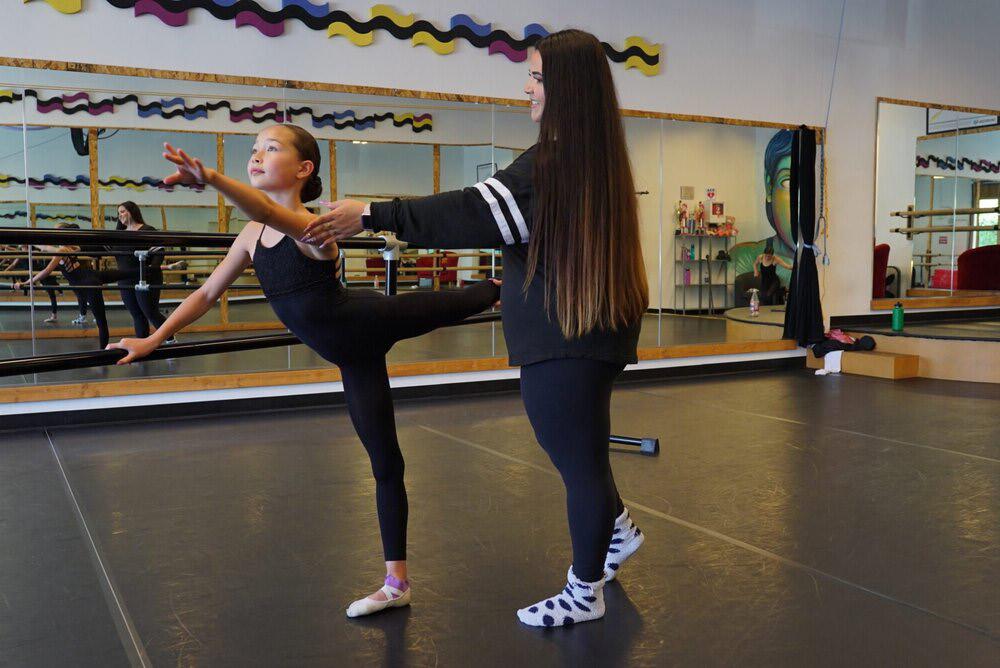 BY SONORA SLATER features@theaggie.org
BY SONORA SLATER features@theaggie.org

Along the hallway at Mirror Image Dance Company in Davis, California, the walls are lined with pictures of students, reminders about Spirit Week, the names of dancers with October birthdays on a green chalkboard and a floor-to-ceiling display of competition awards. At the end of the hallway is a large room, mirrors on both sides and barres on the walls — and in the corner sits a red throne, emblazoned with the letter “M.”
On a normal Monday, dancers in colorful leotards chatted with their friends waiting for class to start, the older girls practicing acrobatic tricks and the younger climbing on every available surface — except for the chair. One girl, new to the studio, walked over and was about to sit down when two more stopped her.
“Wait!” they said. “You can’t sit there. That’s Marlaina’s chair.”
Marlaina Spivey is the co-owner and founder of Mirror Image Dance and is also a chemistry and biology teacher at River City High School. Growing up with two professional dancers for parents, Spivey’s been entrenched in the world of dance her whole life; five hours of ballet weekly was “the rule” in her house.
By founding Mirror Image, Spivey’s had the opportunity to reshape her relationship with dance and work toward changing the way the dance world works — specifically the competition dance world.
As Spivey walked into the room and sat down in her chair, holding a can of sparkling water with pink, bedazzled, inch-long nails, the group came to attention and gathered to sit in front of her.
The first competition of the season was the weekend before, so they planned to spend the class watching videos of their performance and listening to the judges’ critiques.
“Here’s how this works,” Spivey said before they began. “We’re not doing the self-disparaging thing that society tells us to do, where we go, ‘Oh my God, I’m so bad. I can’t watch myself!’ We’re a team. It’s about all of us together. Why do we listen to critiques?”
With well-practiced synchronicity, the dancers chorused, “To get better!”
“Right,” Spivey agreed. “Because otherwise, what’s the point?”
One of the dancers asked Spivey for the team’s score, and two more quickly jumped in talking about a “perfectly-scored” performance they once saw on the hit reality TV competition dance show, “Dance Moms.” Soon, they were all talking about JoJo Siwa, Maddie Ziegler and all the perfect solos they wished were theirs. Spivey joined the conversation.
“You know, our studio has
competed on “Dance Moms” before, and it’s fun to watch, but it’s fake,” she said.
She described the 11-minute-long feigned audience applause they had to participate in, the second staged award ceremony that followed the real one and the changed scores that were set up to heighten the Lifetime series’ drama.
“I’m not saying those dancers don’t deserve it,” Spivey said. “They’re beautiful dancers; they’re extremely talented, but it’s not real. I call it ‘compare and despair.’”
Spivey asked if the dancers know what that means, and when a sea of heads shook “no,” she elaborated.


“It comes from insecurity,” Spivey said. “You can see this thing in someone that you want. It happens a lot through Instagram.”
A girl sitting near the front of the group asked, “Or, like, with Barbie?”
“Yes! Barbie — that’s perfect.” Spivey said, welcoming the interjection. “God, I love you. But yeah, we are not that, and we don’t want to be that.”
This is part of Spivey’s philosophy: she deeply cares about the students she teaches, and she wants them to know that her care isn’t just an act — it’s the real thing.
“My goal is truly to show them genuinely how much I care about them,” Spivey said. “They know when you are feeding them bullsh*t, and they hate it. So I think what I make sure I do most is be genuine and honest.”
Along with showcasing talent and highlighting bonds between girls, competition is also known for cattiness, rivalry and body shaming. According to Spivey, the studio she was at before Mirror Image didn’t want to have a team because they didn’t like the culture of competitions.
“I can’t say I blame them,” Spivey said. “But I believed that I could do it in a healthy way.”
Apart from Spivey’s experience
with dance, she also played soccer and basketball in high school. She said that part of what sets these sports apart from dance is that they have objective wins or losses because “it’s just about the number of baskets in a hoop.” She contrasts this experience to competing in dance, where a dancer’s validation comes from a panel of judges’ subjective opinions.
Back in the studio, Spivey popped open the can of sparkling water and pressed play on the first video. She commented on the judges’ remarks, lamenting the critiques — “It kills me, because we went over those transitions 800 times!” — but also highlighting successes — “You two hit your aerials every time, and I’m very proud of you.”
When the video ended, one dancer spoke up.
“Our timing was so off.”
“Yeah,” Spivey acknowledged. “But we can fix it, right?”
Though she explained that dance competitions can sometimes bring out cattiness and division, Spivey tries to focus on the unifying effects they can have.
“Competing with other studios with the right structure can remove in-house competition,” Spivey said. “It can provide dancers a place to shine, a place to become leaders, a place to belong — that’s what it did for me.”
As far as “in-house competition” goes, Spivey feels strongly about not tolerating “mean-girl sh*t.”
“I’ll find it,” Spivey said. “And I don’t threaten; we have a conversation, teaching them communication, not this passive-aggressive stuff, which we use in such a gendered way.”
“Even there! I said ‘mean-girl,’” she quickly added.
Fostering this unity in a practical way can be hard, according to Spivey. The key? Getting the team in the same place at the same time and letting them talk.
BY CLARA FISCHER arts@theaggie.org
Movie: The Truman Show dir. by Peter Weir (1998)
Ever since watching it in my 9th grade English class, this movie has been one of my all-time favorites. Featuring Jim Carrey at his prime, the film’s premise follows Truman Burbank as everything he takes for truth in his world slowly (then very quickly) unravels around him. The moral questions posed, along with the artistic cinematography and clever script, keeps the audience engrossed for the whole runtime. I always get chills in the closing scene — good at first, as Truman’s decision seems to indicate that humanity will always win, then a little more ominous, as the on-screen viewers immediately flip the channel to find a new, riveting show to watch and their parallel with real-life viewers becomes too close for comfort. This movie hits all the marks to make it a true classic in my book — with a killer soundtrack to boot.
Song: “Everybody Wants to Rule the World” by Tears for Fears (1985)
As I settle into my third year here at UC Davis, I can’t help but feel the sentimental aches of my fleeting teenage years pull at me more and more frequently. My senior friends are experiencing many of their last “firsts,” others are getting excited for their twenty-first birthdays and I’ve almost fought my way through the last of my lowerdivision requirements (though PHY7C is putting up a tough fight). Much like my pick for this week’s album, Tears for Fears has managed to provide a perfect outlet for the anxious, excited, scary, euphoric feelings that come with your last few years as a young adult who’s getting it all figured out. I highly recommend belting this anthem out in the shower a part of your morning routine.
TV Show: Downton Abbey (2010-2015)
Personally, I choose my TV shows exclusively based on how far removed they are from what’s actually going on in my life (just kidding… kind of). A show chronicling the ups and downs of the British upper-class throughout the twentieth century is the perfect watch for when I need to escape the mundanity of regular life without too much emotional investment. The dynamics between the characters are intriguing to follow, the wardrobe choices are gorgeous capsule pieces of a time past and almost the entire script is delivered in a British accent. Need I say more?

Album: “Pure Heroine” by Lorde (2013)
Despite having been released almost a decade ago, I still confidently defend the fact that Lorde’s debut album remains one of the greatest pieces of pop perfection to ever be crafted. Looking beyond the cultural reset that was “Royals,” the album is chockfull of hits that perfectly encapsulate the moodier fall and winter months that are quickly approaching — “Ribs,” “Buzzcut Season” and “White Teeth Teens” come to mind. With her mature view on the world and painfully relatable capture of teen melancholy, Ella Mariji Lani Yelich-O’Connor hit it out of the park with this one.
NETFLIX’S K-DRAMA “LITTLE WOMEN” HIGHLIGHTS THE UNIVERSAL CHALLENGES OF THE RICH AND POOR
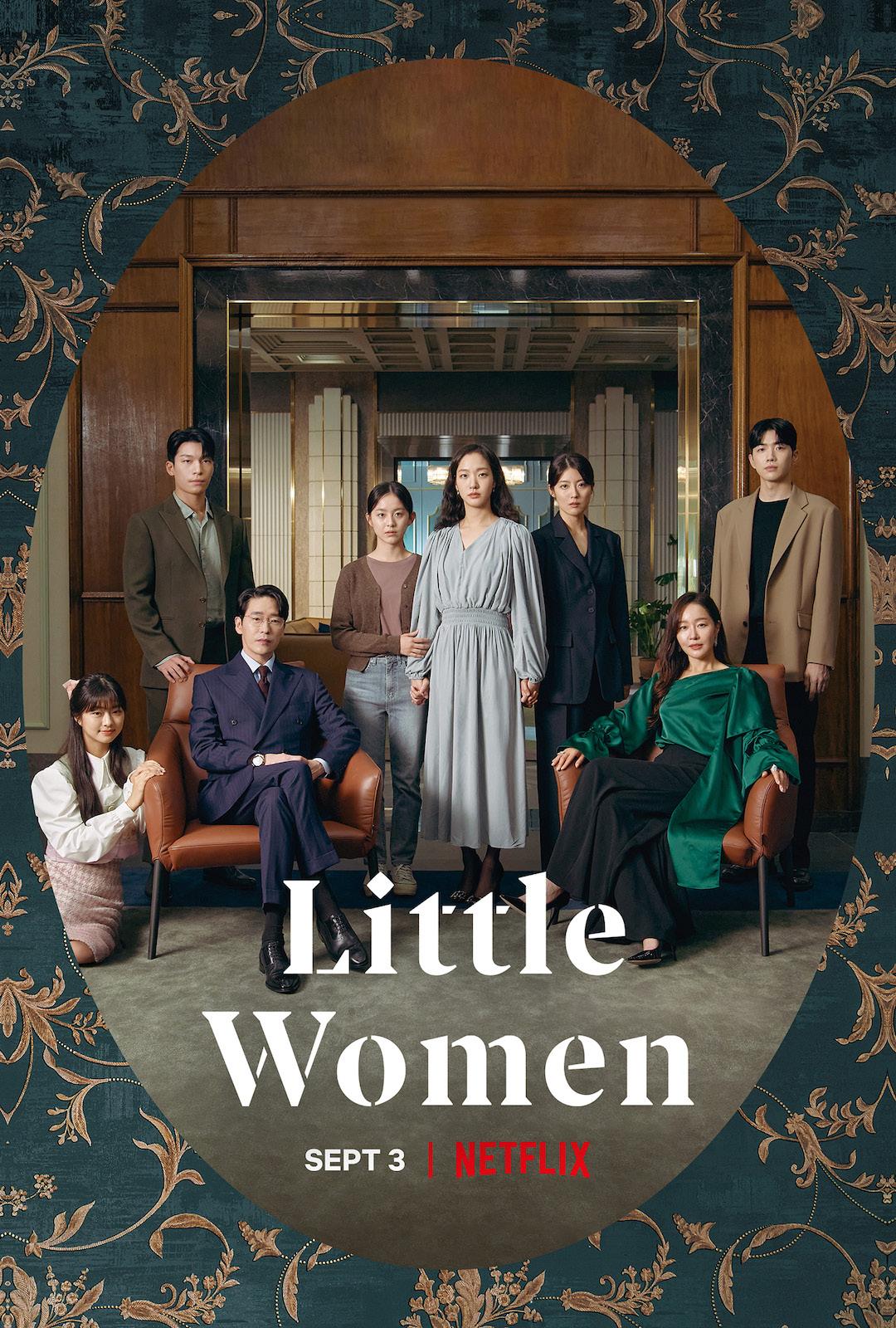 BY SARAH HAN arts@theaggie.org
BY SARAH HAN arts@theaggie.org
Content warning: This article contains discussions of suicide and death that readers may find disturbing.
Netflix’s K-drama “Little Women” depicts the financially challenging lives of the Oh sisters — Oh In-ju, Oh In-kyeong and Oh In-hye. The sisters, who face financial adversity, unknowingly become involved with the wealthy and reputable Park family after In-ju finds her friend Jin Hwayoung dead in Hwa-young’s closet.
Seemingly perfect on the outside yet nowhere close to it on the inside, Park Jae-sang and Won Sang-a are the parents of daughter Park Hyorim. Due to their tremendous wealth and reputation, Park Jae-sang runs to be a candidate for the President of South Korea, while Won Sang-a and Park Hyo-rim pose as the perfect wife and daughter. All the while, they hide away marital conflict, drug addiction and most importantly, the murders of those that get in their way.
In contrast, the Oh family’s problems are relatively transparent; their mother suddenly flees to the Philippines, leaving the sisters with
insufficient money and the unresolved grief of their late sibling who passed away due to the family’s inability to afford healthcare. Another problem arises when In-ju finds her friend Hwa-young dead in her closet. With In-ju’s desire to find the killer and Inkyeong’s passion for investigative news reporting, they suspect the Park family of not only murdering Hwa-young but also being responsible for many other murders.
Right from the beginning, I noticed that “Little Women” established that money can’t fix problems.
Director Kim Hee-won seemed to frequently juxtaposes the Park family and Oh family to show that despite their nearly opposite financial statuses, they deal with the same human problems.
Director Kim’s use of perspectives also shows that nothing can be labeled as ‘good’ or ‘bad’ because everyone has a motive behind their actions.

In-kyeong’s rival news reporter says a quote that encapsulates this perfectly: “We all have our own version of truths. Sometimes, your truth will win. Today, my truth won.”
Even though the rival news editor sides with the antagonist since she works for the Park family, I felt that what she said was not solely out of
attacking In-kyeong. Everybody has their own truth, and although the drama labels the Park family’s side as ‘bad’ and the Oh sisters’ as ‘good,’ we can’t deny that one truth is worth less than the other truth.
Despite this, the show does not make it easy for viewers to empathize with all characters, which is my main critique. Yes, the drama did give a snippet of everyone’s backstory, but I felt that it gave more screen time to the Oh sisters’ and less to the Park family’s. This counters the drama’s intended emphasis on perspectives because it’s not giving equal weight to everyone’s.
You may be thinking the Oh sisters deserve more screen time for their backstories because they are the main characters, but I disagree; I think in order for a drama to accurately portray reality, it needs to give equal weight to all perspectives regardless of the character’s role. The drama needs to incorporate a segment of each character’s past, even if it means a more even distribution of screen time. This way, the viewers can actually empathize with each character rather than pitting them against each other and ultimately see that they all suffer in some way.
4 | THURSDAY, OCTOBER 20, 2022 THE CALIFORNIA AGGIE
The Mirror Image Dance founder aims to teach her students more than technique and choreography
Regardless of financial status, the show portrays how money alone can’t solve human problems
Theatrical release poster of Little Women. (Courtesy of Netflix / fair use)
LITTLEWOMENSHOW on 6
MIRRORIMAGE
on 6
Marlaina Spivey helps a student with her arabesque. (Marlainma Spivey / Courtesy)
THE EDITORIAL BOARD STANDS WITH IRANIAN PROTESTORS IN THE FIGHT FOR WOMEN’S RIGHTS
Content Warning: This article contains discussion of violence which some readers might find disturbing.
On Sept. 13, 22-year-old Mahsa Amini was visiting the Iranian capital with her family when she was arrested by the morality police for allegedly wearing her hijab incorrectly. She died three days later after eyewitnesses reported seeing her being beaten in custody, despite the Tehran Police’s claims that she had suddenly succumbed to heart failure.
Since Amini’s death, Iranians, and especially Iranian women, have taken to the streets to protest the morality police and fight for women’s rights, with many even burning their hijabs to make a statement. Several of these women have faced consequences for their acts of social protest, including 16-year-olds Nika Shakarami and Sarina Esmailzadeh, who were beaten to death during protests, according to eyewitnesses. Official government statements claim that Shakarami died
SEE ONLINE:
to read our online editorial on serial killers in the media.
after falling from a building and that Esmailzadeh took her own life.
These are just a few of the stories coming out of Iran right now — and while these tragedies might feel a world away, there are students and faculty in our community who grew up impacted by restrictive laws and police violence in Iran. Some even have friends and family members still living there.
The Editorial Board stands in solidarity with protestors both in Iran and locally as they fight for women’s rights. We commend the courage of Iranians at UC Davis who have spoken out against injustices in their home country, and encourage others to listen to their stories and take advantage of their right to freedom of speech to talk about what’s happening in the Middle East, if it is safe for them to do so.
The ability of people in Iran to share information, photos and video evidence of what is happening in their country has been restricted by Iranian officials shutting down access to Instagram and WhatsApp and interrupting mobile internet connections. Facebook, Twitter and YouTube have been banned in Iran for years, leaving citizens with very limited options for sharing what’s going on, especially in a way that reaches an international audience.
With such limited information, it is important for those outside of Iran to amplify what does make it through the cracks in order to help the Iranian people tell the world about the human rights violations committed by their dictatorial government.
Other ways to support Iranian communities include joining local protests, like the one held on campus by the UC Davis Afghan Student Association on Oct. 17, signing petitions, such as Amnesty
International’s, which calls for states involved in the United Nations (UN) Human Rights Council to “investigate and ensure accountability for the most serious crimes under international law in Iran,” and donating to relevant organizations.

Two nonprofit organizations that are accepting donations are the Center for Human Rights in Iran, which researches and documents human rights violations across the country and shares them with the public in an attempt to bring about change, and the Abdorrahman Boroumand Center, which similarly uses research and documentation in an effort to help the victims of human rights violations.
It often feels like fighting for change from across the world has no hope of making a difference — and it is true that we are limited in both our ability and our responsibility to reform the Iranian government. But as the stories of protest and government violence in Iran, shared on social media and by word of mouth, have caught the attention of international governments, some change on the world-scale is taking place.
On Oct. 18, the European Union announced sanctions against morality police officials and the Islamic Republic’s Information Minister, freezing their assets in response to their role in the security crackdown against anti-government protests. While this is only a small act of international resistance against the Iranian government, it is an example of how speaking out against injustice can put pressure on world leaders to enact meaningful change.
WRITTEN BY THE EDITORIAL BOARD

WHAT TO DO WHEN YOU CAN’T DECIDE ON DINNER
Indecision in food and life from the point of view of a college senior
BY NADIA ANEES nasaneesl@ucdavis.edu
into a social event and bond with someone over food. I could make it a restful activity and eat in the comfort of solitude. I could turn my need to eat into a creative outlet, playing with different textures, colors and flavors to design a meal. I could turn dinner into an adventure and bring a friend with me to the Co-op to find fun ingredients to cook together. There are so many options. Frankly, it overwhelms me.
opportunities presented to us about how to spend our time in Davis can be extremely overwhelming, beyond deciding what to eat for dinner.

HOW TO SCORE A LETTER OF RECOMMENDATION
 BY JENA TUFAIL jjtufail@ucdavis.edu
AGGIE
BY JENA TUFAIL jjtufail@ucdavis.edu
AGGIE
When I ask myself, “What do I eat for dinner tonight?” my internal dialogue goes a bit like this: A chicken shawarma pita from Sam’s sounds really good. I should save money, though. Didn’t I just buy the Trader Joe’s chicken shawarma? If I eat at home I can watch “Gilmore Girls” and avoid people — that sounds nice. Gosh, I wish I was more social. What if I get Sophia’s with my friend? Sitting outside on the deck eating Pad See Ew sounds like a good way to enjoy this evening in Davis.
When trying to decide what to eat for dinner, my mind runs through every possibility. I could turn eating
Now, in my last year of college, making decisions about something as routine as what to eat for dinner carries bigger implications about how I should be spending my time, resources and energy. A couple of years ago, we didn’t have room for exploration. We were stuck inside, staying within our bubble and spraying our groceries down with disinfectant.
Now that we’re back on campus, we have the option to explore almost anything. College has always provided the freedom to make our own choices, and college post-COVID feels like a heightened sense of that freedom. Within a span of two and a half years, we went from few options to many.
In our post-COVID world as college students, the number of
Even when I’m happily pursuing one choice, I find myself wishing and wondering about the other activities I could be doing. I might be enjoying a coffee and burrito at the Philz in downtown Davis while also wishing to be sitting with friends at the quad, or studying in the reading room in Shields or even getting in a workout at the ARC.
So how do you decide what to eat for dinner (or decide anything for that matter)? I remind myself that no decision can be perfect. You will never have as much information as you need before choosing to do something. What I have learned is that my mindset can help improve my experience, whatever it is I decide to do.
I can tell myself that enjoyment can happen wherever I am. I can remind myself that even though it is my last year of college at UC Davis, there is infinite time and room for good meals, among other things, to happen.
Application season is intense, and whether you are graduating this academic year or in a few, the pressure to get a letter of recommendation can be stressful. If you need a recommendation for graduate school, law school, work or an academic program, it is hard to know when you have developed a relationship suitable enough with a professor, or another individual in a professional setting, who can write you one. Here are my tips for increasing your chances of getting a letter of recommendation.
It’s a good idea to set up some time with your chosen recommender.
Depending on if this is an employer or a professor, this process might vary. Most applications would like an academic letter of recommendation, so I will focus on that.
You can choose to visit a professor in their office hours. Not only can you ask for advice pertaining to the course they are teaching, but most professors will be happy to discuss your professional goals and give you any professional advice if you ask.
Professors have vast experience in their fields and are usually happy to help students discover possible careers after undergrad.
While it’s important for the professor to know you outside of the classroom, as there is more time to discuss other topics, what you do in class also matters. A solid work ethic
is a must: preparing for class, asking for extra help and even asking for opportunities they know about in the field you are studying are great ways to show your dedication.
Participating in class is the perfect way to show your professor that you are actively paying attention and value the coursework. Letters of recommendation need to be personal to some degree, and if you do not make an effort to develop a professional relationship both inside and outside of the classroom, it can be hard to gain a suitable recommendation.
If you do not like speaking publicly in class, that’s all right. Most professors stay after class in order to answer any last-minute questions students might have, so you can catch them then. You can also follow up again in office hours if you need to.
When asking for a letter of recommendation, it’s important to give your chosen recommender ample time. You do not want to bombard a professor with the job of writing you a letter of recommendation on a whim, or a week before it is due. Professors are busy, so they need a few weeks in order to fit in your letter.
When you ask for a letter of recommendation, some professors may also ask to meet with you in order to understand your goals.

THE CALIFORNIA AGGIE THURSDAY, OCTOBER 20, 2022 | 5 OPINION
By listening to and sharing the stories of Iranian people, we can encourage international governments to take a stand against injustice
Scan
On My Plate
FILE
Here are my tips on how to maximize your chances of getting a great letter
LETTEROFREC on 6
JOANNE SUN / AGGIE
MIRANDA LEE / AGGIE
“In recent weeks, Iran has experienced widespread unrest [...] following the death of Mahsa Amini,” the statement reads. “We are deeply saddened by the death of Ms. Amini and those who have lost their lives while protesting in Iran. Last week, the UC Davis Iranian Student Association held a memorial service for Ms. Amini.”
The memorial service was held on Sept. 23 outside of the MU. One student, who asked to remain anonymous due to safety concerns, attended the service and described the experience.
“We were together sharing our emotions,” she said. “We had Iranian students, we had non-Iranian students and faculty, we had Iranians from outside the UC Davis community. It’s complicated — there is sadness, anger, fear. Sometimes we have hope that something is going to change, sometimes we are hopeless.”
Another student, who has also requested anonymity for her safety, said that she felt it was especially important for her to attend the memorial because she had a similar experience while growing up in Iran.
“If you don’t have a proper dress code, [the morality police] can violently arrest you,” she said. “This is what happened to Mahsa Amini, and the same thing happened to me when I was 18.”
Elaborating on the experience, she began to wipe away tears.
According to this student, she was
STRIKE CONTINUED FROM PAGE 1
Yet another shared that “because of rent burden, a good 60% of my stipend goes to my rent. I’m an older nontraditional student who takes care of her elderly parents. So we need a living wage.”
The organizers announced it was time to take the authorization vote. They asked all who wanted to vote ‘yes’ to raise their hands and say ‘aye.’ When asked if anyone opposed, the crowd laughed and raised no objections. Instead, the workers in attendance began to chant the word strike.
More workers in attendance shared their reasons for approving the strike after the vote. Mackenzie Mcfarland
LITTLEWOMENSHOW
CONTINUED FROM PAGE 4
I also found that the show left many questions unanswered. I understand that dramas can seemingly make anything possible because it’s not real life, but I feel like they should aim to depict reality as best they can.
Despite these critiques, I appreciate the drama’s focus on how humanity is the greatest influence on one’s behavior. In the show, money was only the tool that conveyed to me how once one’s humanity is disturbed, they transform into a whole new person. For Sang-a, her humanity was already being tested due to her parents’ relationship. When she accidentally pushed her mother to her death is when her humanity finally broke, resulting in the murder spree of anyone she dislikes.
As for In-ju, money was the only thing that her life revolved around. Even if her sisters were her top priority, this was partly due to the fact that the family didn’t have enough money to save their late sibling from passing away. Moreover, she shows her affection through financial support; for example, she always gives In-hye money so that she wouldn’t have to worry about poverty. But throughout the story, Inju realized that greed only turns people into monsters. Money only provides temporary relief and is not a permanent fix for one’s problems. Therefore, In-ju transformed from a person obsessed
FETALSPINE
CONTINUED FROM PAGE 8
For Farmer, reversing spina bifida’s effects has paved the way for reaching a feasible cure for other neurological diseases.
“We’re starting to work with members of the team on a variety of other neurodegenerative or neural diseases that might be related to inflammation,” Farmer said. “The magic stem cell juice is really magic.
going home from school in Iran when somebody pulled her from the back and dragged her into the street. She was then detained by the morality police for 12 hours, after they decided her attire didn’t fulfill the official dress code.
“I was humiliated there, I was physically assaulted and they treated me like someone who has committed a crime,” she said. “Like I murdered someone. I was just 18 years old at the time, and this is how I got introduced to adult life in Iran as a woman.”
The student said that if she had shared her story under her name, it could be very dangerous for her family members who are still in Iran. The other student who requested anonymity expressed a similar fear.
“It’s hard, because we don’t even feel safe here,” she said. “If we want to go back to our country, there would be some problems if our names got out. Sometimes people don’t understand things, like how worried I am about my younger brother in Iran. They have this sense that there is protesting in the street and that people are getting killed, but there are things they couldn’t understand.”
This student said that to her, this fear to tell the truth is part of what it currently means to be Iranian.
“Honestly, I think this is a part of our stories — that we don’t have freedom of speech,” she said. “We are afraid of telling our real stories about our real lives. That’s a part of the story of all Iranians.”
said she and others did not get paid until November, despite living in Davis since September.
Joseph Wood, a fourth-year Ph.D candidate in material science, talked about why he voted on authorization and why undergraduate students should pay attention to issues concerning their TAs.
“Well obviously rent sucks, losing almost half of my paycheck to rent sucks,” Wood said. “But also, a really close friend of mine basically got bullied out of her lab by her P.I, no repercussions. By the time it will affect you, it’s too late to not care.”
GREENTAPS
CONTINUED FROM PAGE 1
As defined by UC Regents and State of California documents on UC auxiliaries, which TAPS is according to their website, an auxiliary must be self-supporting without state budget support. The TAPS website also states
UCDFOOTBALLVSNAU CONTINUED FROM PAGE 3
“I didn’t even know Miles [Hastings] was running a route until this morning,” Larison said of his contribution to the play.
Despite the blowout, the Lumberjacks continued to fight, putting together a solid drive of 11 plays and 79 yards, resulting in a six-yard touchdown pass from Martinez to Johnson. This play barely chipped at the Aggies’ commanding lead though, making the score 49-13.
The Aggies quickly answered with another scoring drive as Hastings went 3-3, completing a 51-yard pass to sophomore wide-receiver Justin Poerio and two consecutive passes to sophomore tight-end Josh Gale, one of which was an 11-yard touchdown grab that put the Aggies up 56-13 with five minutes left in the third quarter.
Even though the Aggies continued to pile on the points, the Lumberjacks
MIRRORIMAGE
CONTINUED FROM PAGE 4
“Even when you force them to do things they think are dumb and awkward, they can bond over it being awkward,” Spivey said, laughing. “One year I hid painted rocks all around the studio, and it was funny watching 17-year-old girls sprinting around the studio looking for rocks. But they’re together. They’re having conversations.”
As the competition video played on, the dancers took over Spivey’s commentary. One dancer nudged the girl sitting next to her and said, “You killed that turn.” Another turned around to tell the two behind her, “You guys always nail that part.”
Much like in other sports or careers or any group, there’s a certain language that’s only spoken by those on the inside. This is absolutely true for dance, Spivey said, and it’s part of the reason why many of her closest friendships were formed through it.
“The four people I still talk to from high school, they were all on my dance team,” Spivey said. “I didn’t realize it when I was younger, but dance really was such an outlet for me to grow as
that parking citations and passes help the service afford to continue functioning and providing service on campus.
“Increasing rates was a financial necessity to manage Transportation Services’ revenue losses during the
stayed fighting until the end and put together a five-play, 57-yard scoring drive with a rushing touchdown from sophomore running back Draycen Hall to end the third quarter. Northern Arizona now trailed by 36 points.
In the fourth quarter, both teams went back and forth punting the football. The Aggies’ offensive onslaught ended, but the Lumberjacks were able to squeak away another scoring drive with less than two minutes left in the game. The drive lasted 15 plays for 57 yards and ended with a touchdown run by sophomore quarterback Jeff Widener.
This was the last scoring play of the game, leaving the final score at 56-27, which improved UC Davis’s record to 2-4 overall and 1-2 in conference play.
“It’s fun to see them enjoy the fruits of their labor,” Hawkins said of the win. “It’s fun to see them smile, but we got a lot of football left.”
pandemic,” Eggleston said. “The rate increase partly stems from the success of our long-term strategy to reduce vehicle trips to campus by encouraging all modes of sustainable transportation, including biking.”
The Aggies ended the night with 688 total offensive yards, 278 on the ground and 410 through the air. They also scored eight total touchdowns, five on the ground and three through the air. Three of those touchdowns belong to Larison and two to Hutton.
“The cool thing is we have a number of guys who can touch the football,” Hawkins said. “It’s an orchestration of getting everybody involved and using everybody.”
Hastings was the passing leader of the game with an impressive 2126 completion, 328 yards and two touchdown passes. Ulonzo Gilliam Jr. was the rushing leader with 150 yards and two rushing touchdowns.
UC Davis’ next game is against the Northern Colorado Bears on October 22, and their next home game is against the Cal Poly Mustangs on October 29.
about school, their next class and life.
a human.”
She said she tries to make sure that the students at Mirror Image also grow — not just as dancers, but as people.
“I always try to choreograph something with meaning,” Spivey said. “I’ve taught about politics through dance, body image, relationships. I’m doing a piece on infertility this year.”
Despite her emphasis on care and empathy for her students, Spivey believes it’s important to “still have high expectations because they will meet them.”
She explained that this principle applies to her high school students at River City as well, some of whom she said come from homes where they receive less support. Spivey said that maintaining high expectations is how she shows she believes in their potential.
“I think sometimes we judge people for who they are and not who they can be,” Spivey said. When class ended, the dancers left the room in a flood, breathing hard and sweating, waving goodbye to Spivey before restarting their conversations
She called after them, “Goodnight! Love you all!”
Then, she picked up the empty can of sparkling water to toss in the recycling bin before her next class started a few minutes later.
“You really have an impact, whether you’re a good teacher or a bad teacher,” Spivey said. “That kind of started my philosophy, because I wanted to teach them science things, but I realized, I might love science, but they all are not going to be scientists. So am I using my tools to do the good I could do?”
While Spivey of course seeks to teach science and math in her chemistry and biology classes and proper technique in her dance classes, she said she also wants to teach something deeper than that in all of her classes.
“Dance is a tool to help guide young people,” Spivey said. “Many of them will never do anything with it after high school, and I don’t care. I just want them to be good people.”
with financial status to someone who resents chasing money.
Although the series shows how money can transform your humanity, in many moments it also proves that humanity cannot be truly, permanently erased, no matter how extreme the circumstances. This can especially be seen when characters are the most vulnerable. For example, the Park family’s assistant Choi Do-il is very stoic throughout the show; however, he breaks down when he sees his mother lying on the hospital bed, illustrating that even the most outwardly emotionless people still deal with painful feelings.
Sang-ah, despite her obsession with murder, also shows humanity when she expresses regret for and confesses to accidentally killing her mom. Regardless of how corrupt someone is, they still show a capacity for a range of human feelings.
“Little Women” explores how greed and financial hardship affects different characters, showing how people are easily manipulated, deceived and desperate during times of difficulty. However, it also shows that in the midst of financial adversity, people will unwittingly hold onto their humanity. In the end it’s not the money that matters, but the way money highlights the universal difficulties of the human experience.
INDECISION
CONTINUED FROM PAGE 5
If your recommender refuses to write you a recommendation, most of the time it isn’t personal. They may have many other things going on and don’t have the time to write you a strong letter. If it’s not that, you can also ask your professor what tips they have, or what you can do in order to receive a
recommendation.

Even if you do not need a recommendation, getting one is a great opportunity to connect with your professors at UC Davis. The professors here are so knowledgeable in their fields, and are not only great to have a discussion with, but also great people
to get to know.
Disclaimer: The views and opinions expressed by individual columnists belong to the columnists alone and do not necessarily indicate the views and opinions held by The California Aggie.
TRICK-OR-TREATING
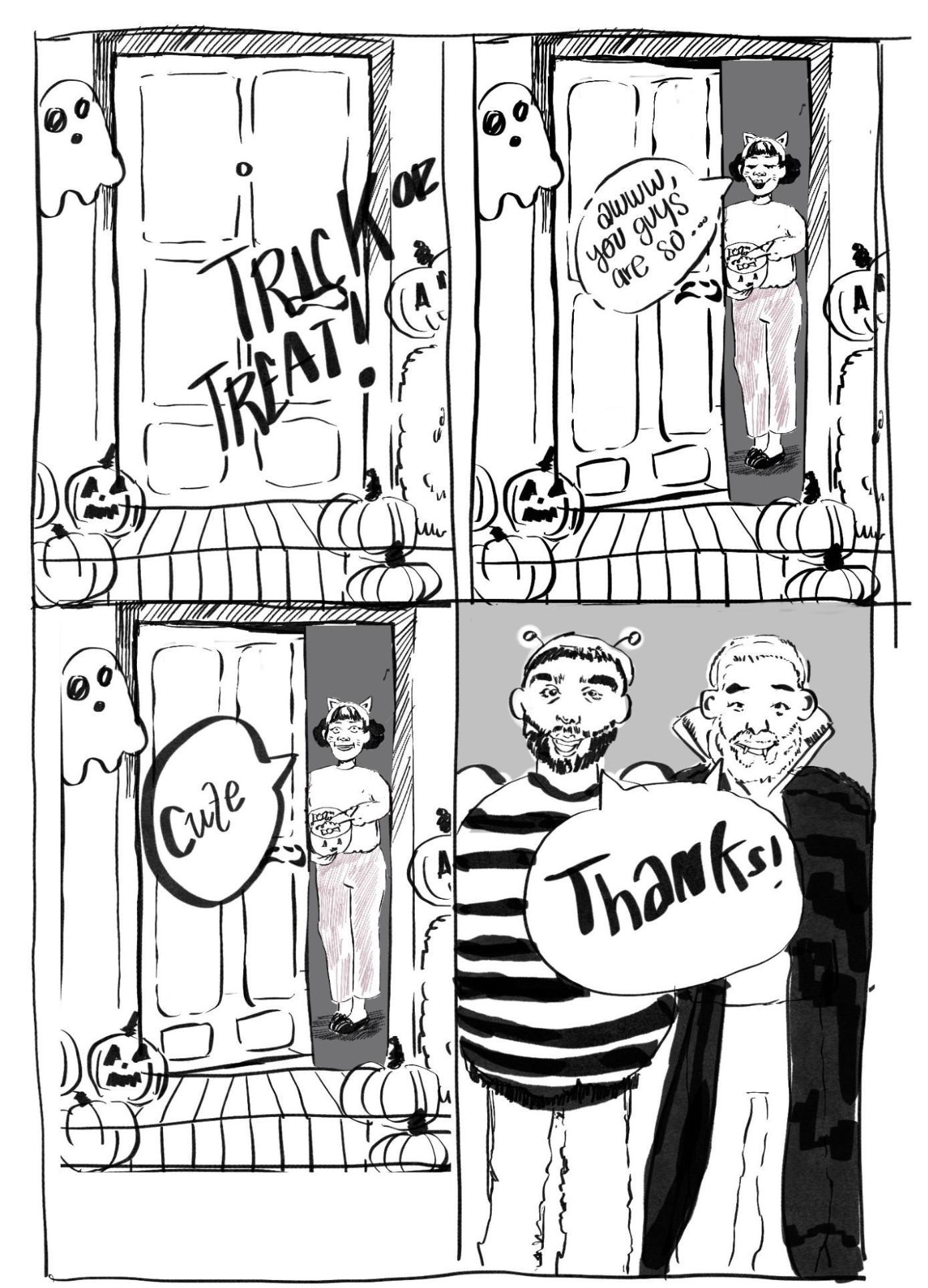 BY PRISCILA JIMÉNEZ CORRALES pjimenez@ucdavis.edu
BY PRISCILA JIMÉNEZ CORRALES pjimenez@ucdavis.edu
If you think about it, the placenta is a very interesting organ. It goes from nothing to being done and fully formed and dying essentially in nine months. The organ makes big blood vessels and protects the fetus from being rejected. So I think there’s going to be more potential on placental research as well as further stem cell applications.”
6 | THURSDAY, OCTOBER 20, 2022 THE CALIFORNIA AGGIE
Disclaimer: This cartoon is humor and/or satire, and its content is purely fictional. The story and names of
“sources”
are fictionalized.
IRANPROTEST CONTINUED FROM PAGE 1
Enter digits from 1 to 9 into the blank spaces. Every row,


and 3x3 square must contain each
Each Sudoku has a unique solution that
logically without guessing.
THE CALIFORNIA AGGIE THURSDAY, OCTOBER 20, 2022 | 7 SUDOKU
column
digit.
can be reached
Answer to previous puzzle 10/13/22 CROSSWORD Answer to previous puzzle 10/13/22 Scan to upload your completed crossword for the chance to win a prize!
UC DAVIS HEALTH CONDUCTS WORLD’S FIRST STEM CELL TREATMENT FOR SPINA BIFIDA
The procedure marks the first time paralysis has been successfully cured in utero
BY BRANDON NGUYEN science@theaggie.org
For the first time in the world, UC Davis Health successfully cured paralysis and predicted associated neurological defects with spina bifida for babies in utero during fetal surgery.
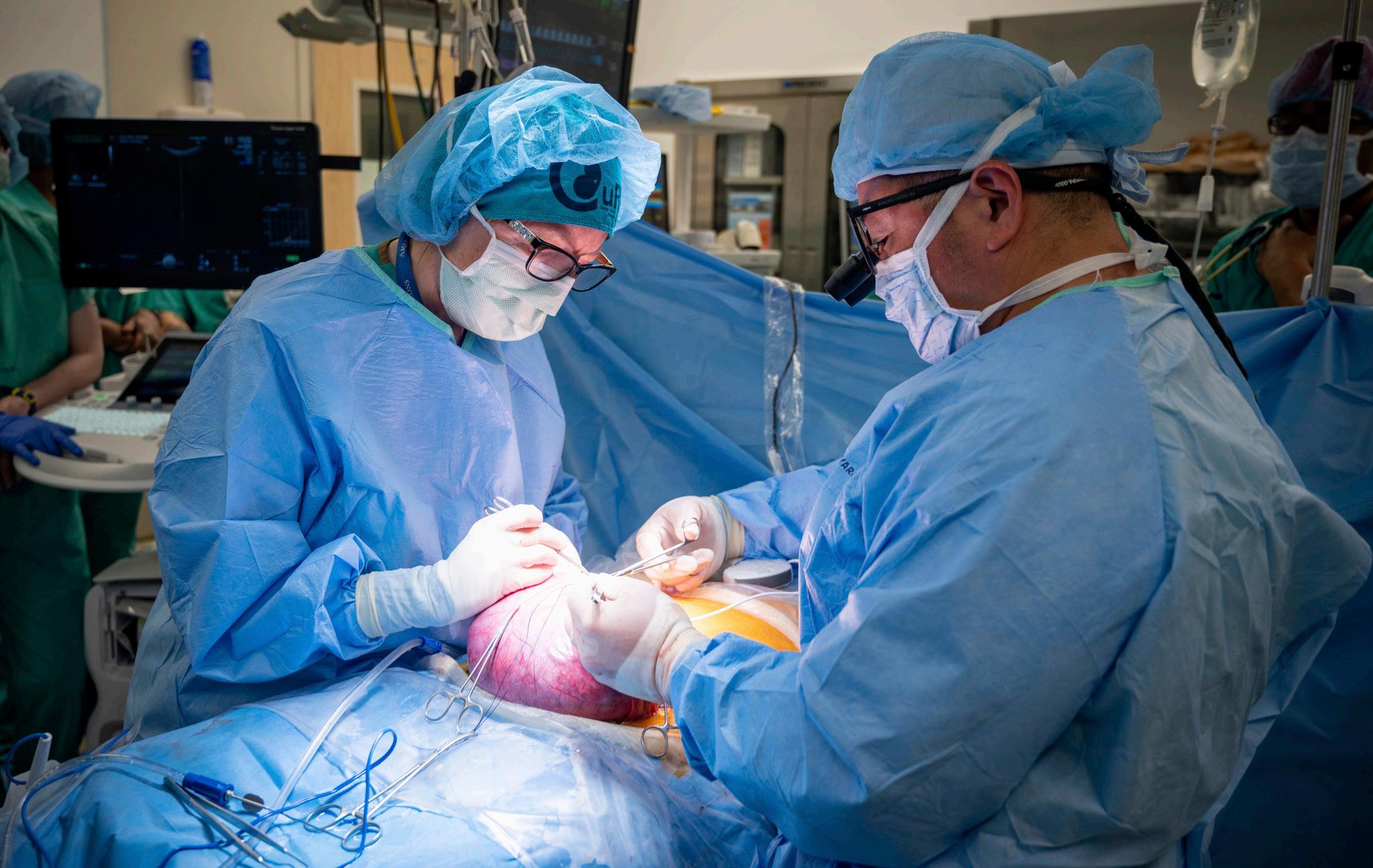
According to UC Davis Health’s website, spina bifida, also known as myelomeningocele, is not uncommon, affecting 1,500 to 2,000 children in the U.S. annually. This neurological condition is diagnosed through a blood test and ultrasound screenings when spinal tissue fails to fuse properly during the early stages of pregnancy, which can lead to a multitude of lifelong disabilities related to cognitive function, mobility and urinary and bowel movements. Until now, fetal surgery alone did not guarantee recovery in these patients, but with the rise of stem cell technology, hope for a cure is much closer to reality. Dr. Diana Lee Farmer,
the chair for the Department of Surgery as well as a trained fetal surgeon at UC Davis Health, launched the landmark CuRe Trial, which stands for Cellular Therapy for In Utero Repair of Myelomeningocele, in spring 2021 to begin recruiting patients to test their placental stem cells during fetal surgery.
Farmer has dedicated over 20 years to searching for a cure for this condition, but she explained that regenerative stem cell therapy only recently became a feasible solution.
“For Spina bifida, kids don’t die, but it’s terrible,” Farmer said. “They’re born paralyzed for the rest of their life, and there’s really nothing anybody could do at the time. They have fluid on their brains; they can’t pee or poop. They have to have special devices to help with urinary and bowel movements. It’s not fatal, but it’s devastating to both patients and families and the cost to society.”
According to Farmer, the stem cells her team extracted came from the placenta, which she said is an organ
that is rich in cells undergoing constant regeneration but is often thrown out following a baby’s delivery.
“We discovered that these unique placenta-derived stem cells had special characteristics,” Farmer said. “They sort of secrete what I call ‘magic stem cell juice.’ In addition to protecting the spinal cord — at least in our animal models and in how our bulldogs respond to it — it looks like it reversed some of the damage that was already done, because we had complete recovery in those experimental models. So we worked hard to get donor placentas and extract the cells and engineer them [...] and eventually got approval from the FDA to do the first human studies to see if this was going to be safe in humans.”
Dr. Aijun Wang, a trained bioengineer and an associate professor of the Department of Surgery for the UC Davis School of Medicine, helped Farmer develop the stem cell patch to be used in the surgery. Preliminary work by the two showed that prenatal surgery
combined with the human-placentaderived stem cells, held in place with a biomaterial scaffold to form a “patch,” helped lambs with spina bifida walk without noticeable disability.
“When the baby sheep who received stem cells were born, they were able to stand at birth and they were able to run around almost normally; it was amazing,” Wang said.
The team also altered the technique used on lambs that combined surgery with stem cells for canines. When both the models on lambs and canines restored the animals’ ability to walk, Farmer and her team moved to begin a human trial.
One patient who took part in the CuRe trial was Michelle Johnson, who flew down with her husband Jeff Maginnis from Portland, Oregon to receive the placental stem cells during fetal surgery. Johnson detailed the rollercoaster of emotions she felt upon hearing the diagnosis.
“I remember that around the
twenty-week mark in the gestation period, I received a call from my radiologist following my ultrasound,” Johnson said. “His voice was trembling, and he had told me that my baby had a spinal defect called spina bifida. I got off the phone, thinking, ‘what is spina bifida?’ It’s not genetic; it’s very random in presentation. I had no control over this, so why me and why my child?”
Johnson said that the diagnosis left her feeling like she had no options, but the CuRe trial at the time became the miracle she needed.
“I was willing to do anything to give our baby the highest quality of life possible, and that’s when I heard about the CuRe trial,” Johnson said. “We could’ve lost our careers in risking a lot when we moved down to Davis, but it was worth giving our son the ability to walk. Tobi is a little miracle; he’s about to crawl and is the happiest baby in the world.”
FETALSPINE
TENUOUS TETHERS: UC DAVIS STUDY ON HOW DNA CHROMOSOMES LINK WITH EACH OTHER DURING MEIOSIS
Understanding the process of chromosome pairing in meiosis is important to prevent biological defects in genetics
BY YASH RATHI science@theaggie.org
In meiosis — the process through which all the sex cells multiply in eukaryotes — homologous chromosomes pair with each other through recombination. If during this process, there is an incorrect pairing of chromosomes, this defect can lead to miscarriages or birth defects.
Dr. Sean M. Burgess, a professor in the Department of Molecular and Cellular Biology at UC Davis, is interested in the process of meiosis and how chromosome pairing happens. Burgess and her colleagues conducted a study that appeared in the National Academy of Sciences which provided some insights into the homologous pairing of chromosomes in meiosis.
“Critical to this process are the pairing, recombination, and segregation of homologous chromosomes (homologs),” the study reads. “While pairing and recombination are linked, it is not known how many linkages are sufficient to hold homologs in proximity.”
To better understand the underlying mechanisms behind chromosomal pairing, the researchers used live-cell imaging to watch the pairing occur in real time.
“We were interested in meiosis and how chromosomes segregated into different gametes and what the process of chromosomes coming together is,” Burgess said. “There have been static images of chromosome pairing for like 100 years, but we wanted to see it in real
time. That’s why we developed a system where we can actually see chromosomes and do live-cell imaging and watch chromosomes move around in space relative to each other.”
For this research, the team created a strain of budding yeast so that their chromosomes had fluorescent markers. They used light-imaging microscopes to visualize the process. When the cell entered the early phases of meiosis, they took measurements of the chromosome every 30 seconds for 25 minutes.
From these measurements, Burgess’ lab developed an algorithm called “SeeSpotRun,” which helped them to determine the chromosomal sites in a three-dimensional space.
“We took a yeast’s chromosome, and we integrated these DNA sequences, which bind to the repressor proteins,” Burgess said. “It is a tool which we can use to tag a chromosome with a fluorescent dye. We introduced chromosomes with one of these sites and replicated the chromosomes and did our study on it. In some cases, the chromosomes were together, but in some cases, they were apart. We were interested in how these chromosome pairs split during the formation of sex cells.”
Burgess and her team noticed that these homologous chromosomes were not stable during pairing, but they are dynamic. Only a few tethers were required to keep the pairs bound together. This was the first time that any researcher provided a live view into interchromosomal dynamics in the process of sex cell division.
In her study, Burgess found that two to four linkages are required to keep these homologous chromosomes together. She explained that this might be because when two to four linkages are present, they create an inhibitory signal that prevents the linkage of other chromosomes nearby.
After completing her research, Burgess reached out to colleagues at Stanford University who were
conducting similar research to see if their work might corroborate her results. Their conclusions and data matched with the data that Burgess’ team collected during the research done at UC Davis on yeast.
“They were interested in chromosomes as polymers and how these giant polymers move around in a confined space in the nucleus,” Burgess said. “They have developed some math
models, and we had this ideal situation where they could see what kind of match they had with our study.”
Burgess said that she and her Stanford colleagues will be continuing to research the topic, further examining the process of homologous pairing in meiosis in hopes of uncovering what exact process helps chromosome pairing to occur error-free.
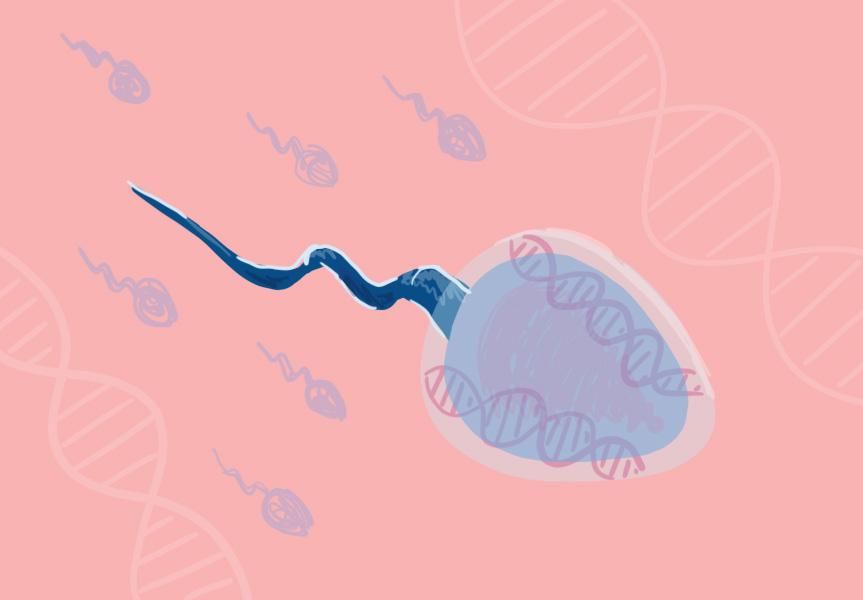
8 | THURSDAY, OCTOBER 20, 2022 THE CALIFORNIA AGGIE SCIENCE AND TECH
UC Davis Health team of fetal surgeons, nurses, and scientists deliver stem cell treatment during fetal surgery for CuRe Trial in the operating room. (UC Davis Health / Courtesy)
on 6
MIRANDA LEE / AGGIE
















 BY GABRIEL CARABALLO sports@theaggie.org
BY GABRIEL CARABALLO sports@theaggie.org

 BY SONORA SLATER features@theaggie.org
BY SONORA SLATER features@theaggie.org



 BY SARAH HAN arts@theaggie.org
BY SARAH HAN arts@theaggie.org




 BY JENA TUFAIL jjtufail@ucdavis.edu
AGGIE
BY JENA TUFAIL jjtufail@ucdavis.edu
AGGIE


 BY PRISCILA JIMÉNEZ CORRALES pjimenez@ucdavis.edu
BY PRISCILA JIMÉNEZ CORRALES pjimenez@ucdavis.edu



